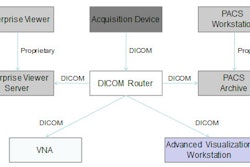Nowhere was the tenuous relationship between radiology and information technology departments more present than at the Healthcare Information and Management Systems Society (HIMSS) annual meeting, held in Orlando, FL, last week.
Much as IT feels like a fish out of water at the annual RSNA conference, so, too, was radiology at HIMSS. Both shows featured an array of products and services related to radiology, yet each also catered to its own groups.
 |
| Michael J. Cannavo |
There were also a few independent PACS providers out there, but most seemed to be floundering in a sea of IT solutions in which radiology was more or less the odd man out. There was a lack of educational seminars, and even showing how radiology was integrated into the healthcare environment in the HIMSS Interoperability Showcase was limited.
This should come as no great surprise to anyone in radiology who has attended HIMSS in recent years, as HIMSS really hasn't given radiology a strong push to the front of the line. That is something HIMSS definitely needs to work on.
While HIMSS bears some responsibility for the lack of radiology presence at an IT-centric show -- and radiology has indeed become IT-centric -- as I walked around I had to ask a deeper question: "Who is responsible for educating IT about all things radiology-related ... radiology or IT?"
I queried several vendors who were at the show, and they said that chief information officers, chief technology officers, and others they talked with seemed to fall into two categories: those who were exceptionally knowledgeable about what they were looking at, and those who were half a step above clueless. There was no middle ground.
Those who were knowledgeable -- as was the case with most folks who looked more closely at vendor-neutral archives (VNAs) -- brought themselves up to speed on the technology and benefits by attending online webinars, reading white papers, getting information from vendors, and knowing what questions to ask to evaluate the technology. Interestingly, the same in general could not be said about those looking at PACS and RIS -- although few attendees seemed to look at RIS and PACS except, perhaps, peripherally. Most who did look closely at PACS and RIS usually came to look at a specific vendor as requested by their radiology department.
That said, the problem is that looking at it and knowing what you are looking at are two different things. Unfortunately, with HIMSS being an IT show, most IT folks were on their own without any guidance from radiology.
PACS, both radiology and cardiology, are the proverbial horses of a different color. Most clinical information systems don't address workflow to the same degree that PACS does. This requires input at various levels within the department, from scheduling staff and radiologic technologists to radiologists, administrators, and others. For this reason, most radiology departments have, until recently, pretty much called their own shots regarding which PACS, RIS, speech recognition, and other clinical information systems were used by radiology.
A few years ago this started to change, and now with the American Recovery and Reinvestment Act/Health Information Technology for Economic and Clinical Health (ARRA/HITECH), IT is not only in the game, it has become one of the primary shot callers. Initially, this didn't sit very well with radiology, but the realization that there has to be a synergy between radiology and IT is very real.
Radiology can no longer be an island of automation; instead, it's tasked with being a hugely important part of the electronic health record (EHR) that needs to work seamlessly with other clinical information systems. For this reason, IT can and must be involved.
So back to the question: Who is responsible for educating IT about all things radiology-related? In theory, IT should learn all it can on its own. In practice, radiology also bears a responsibility to help IT learn as much as it can.
IT has a bad case of information overload, with a 2015 deadline looming to achieve stage 7 of "meaningful use" adoption of electronic medical records (EMRs). Only 49% of all facilities are at stage 3 in the adoption model, which includes PACS; less than 9% are at stage 4 or higher and just 1% are fully electronic.
According to HIMSS Analytics, nearly 32% of hospitals in the U.S. are stage 0, 1, or 2. At these levels, hospitals can't or don't give physicians access to images outside the radiology department via the organization's intranet, let alone the Internet. That's four years for roughly 1,600 hospitals of the 5,000 or so U.S. community-based hospitals to implement PACS, and for the remaining 3,200 others to integrate their PACS into a complete patient health record (PHR).
To date, only 3.2% of U.S. hospitals are at stage 6, which includes full PACS in a completely filmless environment, although I'm sure this deals more with the other clinical information systems relative to PHR adoption than PACS itself.
Can we get to stage 7 with this many barriers ahead of us? I wouldn't bet on it, but then I'm a realist, not an optimist. I don't think anyone inside or outside healthcare thinks it will be done by this date either, but if it is to be done, radiology needs to work with IT.
We also need to be more cognizant of standards adherence. Most vendors support (or at least claim to support) DICOM and HL7, but support for Integrating the Healthcare Enterprise (IHE) is still very spotty. Within the next five years, virtually every proprietary archive currently in place with existing PACS should be displaced by VNAs.
The problem here, though, is that there is no clear-cut definition of what exactly is a VNA (each vendor has a "one-off "definition). There also is no clear understanding of what is gained (or lost) by migrating data from a proprietary format, what the real costs are, and so on. There are resources for this information, but radiology needs to take the lead in providing the pointers to IT. This will help them get educated and be able to ask the right questions and pick the right archive solution, not just for radiology but for the enterprise as a whole.
More to the point, vendors need to get together and work together as well. We can talk about VNAs until we're blue in the face, but do we really need a radiology-specific VNA? Isn't it better instead to position the archive as a clinical (or central) data repository that accepts input from multiple "-ologies" in multiple formats and allows the data to be utilized by many through a single viewer?
Vendor neutrality maybe one of several goals, but it is not the ultimate goal. The ultimate goal is one repository for all data that is easily accessed, easily replicated, and, above all, easily integrated. Radiology needs to get out of its own world and share what it has learned, and this includes allowing VNAs to be used enterprise-wide to save time, space, and effort. Radiology has a plethora of resources available to us, and we need to share with our IT brethren.
It's easy to point out the weaknesses of HIMSS and IT for "excluding" radiology, and they do deserve at least a hand slap for this faux pas for sure. But as the saying goes, when one finger is pointing outward at others, there remain three others pointing back at ourselves. The journey towards a PHR cannot be done alone -- radiology needs IT's help and vice versa -- and we have no choice but to work together toward this common goal.



















